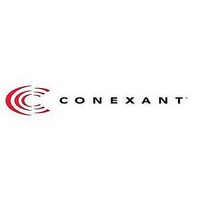bt8375kpf Conexant Systems, Inc., bt8375kpf Datasheet - Page 210

bt8375kpf
Manufacturer Part Number
bt8375kpf
Description
Single Chip Transceivers For T1/e1 And Integrated Service Digital Network Isdn Primary Rate Interfaces Systems
Manufacturer
Conexant Systems, Inc.
Datasheet
1.BT8375KPF.pdf
(323 pages)
Available stocks
Company
Part Number
Manufacturer
Quantity
Price
- Current page: 210 of 323
- Download datasheet (3Mb)
3.16 Data Link Registers
DL1_BIT[7:0]
TDL1_RPT
DL1[1: 0]
3-92
0A5— DL1 Bit Enable (DL1_BIT)
0A6— DL1 Control (DL1_CTL)
DL1_BIT[7]
—
7
7
DL1_BIT[6]
DL1 Bit Select—Works in conjunction with DL1_TS [addr 0A4] to select one or more time
slot bits for data link input and output. Any combination of bits can be enabled by writing the
corresponding DL1_BIT active (high). The LSB enables first bit transmitted or received, and
MSB enables eighth bit transmitted or received. DL1_BIT has no effect when DL1_TS selects
T1 F-bits.
The Circular Buffer/FIFO control bit [TDL1_RPT; addr 0A6] allows the FIFO to act as a
circular buffer; in this mode, a message can be transmitted repeatedly. This feature is available
only for unformatted transmit data link applications. The processor can repeatedly send fixed
patterns on the selected channel by writing a 1- to 64-byte message into the circular buffer. The
programmed message length repeats until the processor writes a new message. The first byte of
each unformatted message is output automatically, aligned to the first frame of a 24-, or
16-frame transmit multiframe (SF/ESF/MFAS). This allows the processor to source overhead
or data elements aligned to the TX timebase. In both SF and ESF T1 modes, unformatted
messages are aligned on 24-frame boundaries. Therefore, in SF applications, the repeating
message must be designed to span two SF multiframes. Each unformatted message written is
output-aligned only after the preceding message completes transmission. Therefore, data
continuity is retained during the linkage of consecutive messages, provided that the contents of
each message consist of a multiple of the multiframe length.
Data Link 1 mode—Selects either HDLC-formatted Frame Check Sequence (FCS) or
Non-FCS transmit and receive data link message mode or unformatted (Pack8 or Pack6)
message mode. During HDLC modes, the transmit/receive circuits perform zero
insertion/removal after each occurrence of five consecutive 1s contained in the message bits,
FLAG (0x7E) character insertion/removal during idle channel conditions, and ABORT (0xFF)
code insertion/detection upon errored channel conditions. Refer to ITU-T Recommendation
Q.921 for complete details of the HDLC link-layer protocol. FCS mode automatically
generates, inserts, and checks the 16-bit FCS without passing FCS bits through transmit and
receive FIFOs. Non-FCS mode passes all message bits that exist between the opening and
closing FLAG characters through the FIFOs, without generating or checking FCS bits.
Non-FCS mode allows the processor to generate and check the entire contents of each HDLC
frame.
bit transmitted is supplied by the processor through TDL1, and each bit received is passed to
the processor through RDL1 [addr 0A8]. Pack8 and Pack6 unformatted mode options select
the number of bits per byte that are stored in transmit/receive FIFOs—8 or 6 bits, respectively.
—
Unformatted data link modes provide transparent channel access, in which every data link
6
6
DL1_BIT[5]
—
5
5
0 = disable data link bit
1 = enable data link bit
DL1_BIT[4]
TDL1_RPT
4
4
Conexant
DL1_BIT[3]
DL1[1]
3
3
Fully Integrated T1/E1 Framer and Line Interface
DL1_BIT[2]
DL1[0]
2
2
DL1_BIT[1]
TDL1_EN
Bt8370/8375/8376
1
1
DL1_BIT[0]
N8370DSE
RDL1_EN
0
0
Related parts for bt8375kpf
Image
Part Number
Description
Manufacturer
Datasheet
Request
R

Part Number:
Description:
Bluetooth RF Transceiver
Manufacturer:
Conexant Systems, Inc.
Datasheet:

Part Number:
Description:
Bluetooth RF Transceiver
Manufacturer:
Conexant Systems, Inc.
Datasheet:

Part Number:
Description:
ATM transmitter/receiver with UTOPIA interface
Manufacturer:
Conexant Systems, Inc.
Datasheet:

Part Number:
Description:
Service SAR controller
Manufacturer:
Conexant Systems, Inc.
Datasheet:

Part Number:
Description:
CN8223EPFATM Transmitter/Receiver with UTOPIA Interface
Manufacturer:
Conexant Systems, Inc.
Datasheet:

Part Number:
Description:
Embedded modem family
Manufacturer:
Conexant Systems, Inc.
Datasheet:

Part Number:
Description:
Fully integrated T1/E1 framer and line interface
Manufacturer:
Conexant Systems, Inc.
Datasheet:

Part Number:
Description:
Flicker-free video encoder
Manufacturer:
Conexant Systems, Inc.
Datasheet:

Part Number:
Description:
Home Networking Physical Layer Device with Integrated Analog Front End Circuitry Data Sheet (Preliminary) CX82100-41Home Network Processor (HNP)
Manufacturer:
Conexant Systems, Inc.
Datasheet:

Part Number:
Description:
Manufacturer:
Conexant Systems, Inc.
Datasheet:

Part Number:
Description:
Manufacturer:
Conexant Systems, Inc.
Datasheet:

Part Number:
Description:
Manufacturer:
Conexant Systems, Inc.
Datasheet:

Part Number:
Description:
Flicker-free video encoder
Manufacturer:
Conexant Systems, Inc.
Datasheet:

Part Number:
Description:
SmartV.XX Modem
Manufacturer:
Conexant Systems, Inc.
Datasheet:

Part Number:
Description:
Multichannel synchronous communications controller
Manufacturer:
Conexant Systems, Inc.
Datasheet:











